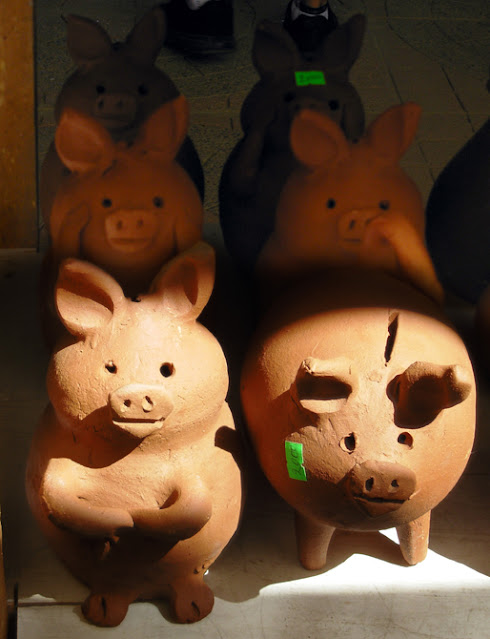Pomaire : Heart of Clay
Surrounded by verdant vineyards, fields of crop and fruit plantations, and nested within mountains rich in clay, Pomaire was an indigenous settlement before the arrival of the Spaniards in the XV century.
The name of the village comes from the chieftain of the first human settlement of this area, the Curaca Pomaire. Two centuries later, the growth of the village forced them to re-settle to its current location.
Although pottery was already crafted by the villagers at this time, it was not but until the second half of the XIX century when they began creating implements for commercial purposes, selling them in the markets of the Valparaíso area.
Sales were good, and over time the fame of the Pomaire’s pottery grew, specially for its sturdy cooking pots, which were not only perfect for use in wood-fired ovens but also lent a particular character to the food prepared in it.
Unlike the pottery from other regions, the Pomaire clay pottery is of brownish orange color, thick, with a smooth finish and round edges, bearing no design or paint. It can be found in different versions: burnished, varnished or darkened, in utilitarian designs or representing the typical motifs of the region.
Under the skilled hands of the artisan, the clay is moistened and worked with masterful patience.
Depending on the object, few to no implements are used to give it shape - usually, a simple spatula or a wooden knife.
Moulds are not used - the mastery of each potter is the sole source of each creation, and as such, each piece is unique and unrepeatable.
Once the figure or implement is finished, it is cooked in a wood-fired kiln up to 600-800 C.
Pottery training starts usually at a very young age, with children copying their parents or relatives in the craft, continuing the traditions generation after generation.
Women usually craft small and medium-size pieces, and men craft the larger objects.
One particular specialization, the making of clay miniatures, is rapidly disappearing due to its delicate technique. In this, each piece is crafted almost with as much detail as a larger piece, but none surpasses 1 cm in height.
Larger pieces (about 2cms in height) are sold in groups tied in strings, but even these are hard to find nowadays.
Over the years, the artisans have diversified their products in order to keep up with the times, but never losing touch with their roots. Thus, we can find pots, tea and coffee sets, cooking ware, plates, spoons, garden icons and home adornments of all sizes, but also lamps, magnetos and key rings, all in the typical red clay of the town, either plain, darkened, painted or enamelled.
However, some typical folk motives have withstood the test of time: old shoes (a good luck charm for the garden), old kitchens, hens, pigeons, tea pots, lady gardeners, and little piggies (a good fortune charm) in many variations.
Although the clay in Pomaire is of a brownish orange color, some items are ‘blackened’ using burnt newspaper after the cooking process in the kiln. For this reason, these pieces have ‘dots’ of brown color, making each one a unique piece.
In addition, some stores offer items in white clay, a rarity which lends the typical figurines a special character with its sand color finish.
Today, Pomaire hosts nearly 100 different artisan stores and workshops across in its main two parallel streets, ‘Roberto Bravo’ (in honor of the famous Chilean pianist), and ‘San Antonio’.
Along them, one can find native woodwork, raffia furniture, toys, novelties, artisan food preserves and, of course, clay pottery.
The stores attract a considerable number of visitors, both local and foreign, who come to check the workshops and enjoy typical Chilean food, the specialty of the area.
Among the artisan stores and workshops, you can also find many restaurants and picás (small places to grab a quick bite) in an array of qualities, at the reach of all pockets.
Some best-selling specialties are : pastel de choclo (meat pie of minced beef, chicken, boiled egg and olives covered by a thick layer of creamed corn, cooked in the oven in individual clay pots), empanadas of all sizes, roasted meats, humitas (similar to Tamales, but bigger and sweeter), and huesillos con mote (a dessert/juice of boiled peaches with husked wheat, served chilled during Summer).
Pomaire is small, simple and unpretentious, but that is exactly where its charm resides. Visitors will find in this small town a taste of what a typical Chilean town was in times gone by.
If you go, cast away your watch and enjoy the timelessness. Pomaire is well worth a visit for a taste of folklore, a special souvenir, and a piggy for luck!
For more information about Pomaire and other touristic attractions in the area:
https://www.visitchile.com/en/pomaire-maipo-valley/attractions.htm
You can also download for free the book "Trades and Works of the Women of Pomaire", which provides detailed information about the history of Pomaire and the pottery trade in the region (In Spanish Only).
http://www.memoriachilena.cl/602/w3-article-92352.html




















Comments
Post a Comment